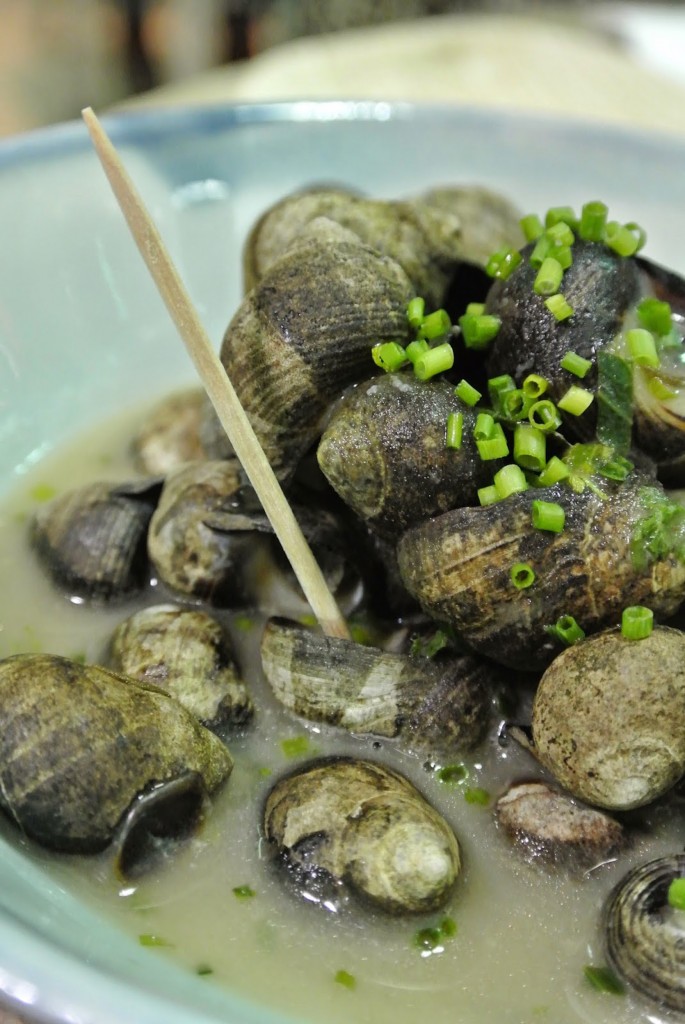Loyal Nine in Cambridge, Massachusetts, focuses on new England cuisine. Though periwinkles have only been in Massachusetts since the nineteenth century, chef Marc Sheehan shows how these snails could become a tasty addition to locally sourced seafood. The recipe below is for the dedicated cook.
Periwinkles
3 cups periwinkles
Rinse periwinkles in cold water until the water runs clear. Drain. Place periwinkles in heavily salted water to purge for one hour. Rinse again. Drain and keep cold.
If buying periwinkles, rather than harvesting them, 1 pound of snails is good for this recipe.
Dulse Broth
4 sheets dried dulse seaweed
1 sheet Atlantic kelp
1 pound mirepoix
1 cup apple peels and cores (discards from apple puree, below)
1 2-inch piece ginger
1 head garlic, split
1 gallon water
3 sprigs rosemary
3 sprigs thyme
Fines herbes stems
1 teaspoon black peppercorns
1 teaspoon coriander seed
1 teaspoon fennel seed
Add mirepoix,* ginger, garlic, and spices into a pot. Cover with water and bring to a boil. Simmer slowly for 20 minutes until vegetables no longer float.
Add in herbs.
Return to a boil and add in seaweed.
Remove from heat, cover, and steep for 30 minutes. Strain. Adjust seasoning. Add in more seaweed to steep if needed.
*Marc Sheehan makes his mirepoix with 2 parts onion, 1 part carrot, 1/2 part celery, but the food.com link is easier to follow.
Apple Puree
4 shallots, peeled and thinly sliced
6 green apples (Granny Smith or Rhode Island Greening) peeled, cored, thinly sliced
extra virgin olive oil
2 to 3 ounces hard cider (ideally something with funk and no added sugar)
2 sprigs rosemary
salt
pepper
Sweat the shallots in olive oil until half cooked.
Add apples and sweat down.
Add in rosemary and hard cider. Continue to cook until apples are mushy.
Remove the rosemary.
Puree. Season with salt and pepper.
Add a little honey or boiled cider if sweetness is needed. Pass through a chinois and chill.
Onion Puree
4 white onions, peeled and diced small
grapeseed oil
salt, to taste
lemon juice, to taste
Place a heavy-bottomed pot over medium-high heat. Add in the grapeseed oil, just enough to coat the bottom.
Add in onions and season with salt.
Add in a little more grapeseed oil to coat the onions. Should be dressed like a salad.
Color the onions and let them sweat quickly without achieving any color. You want this as white as possible. Once onions are fully cooked with no crunch, drain them in a colander to remove excess fat and liquid.
Place the onions in a blender and blend on high.
Season with salt if necessary and add lemon juice to taste.
Pass through a chinois and chill.
Periwinkles and Broth
8 ounces cider
Cider vinegar
Butter
Lemon juice
Chives, minced
Sourdough bread, sliced, buttered, and grilled
Add thyme and hard cider to a saucepot. Bring to a boil and reduce by half.
Add the dulse broth and bring to a boil. Add in periwinkles and cover. Boil 1 to 3 minutes until periwinkles have opened up and expressed their liquid. Remove periwinkles and keep hot.
Strain broth through a sieve into a separate pot.
Add in apple puree, onion puree, and butter to make a light sauce.
Season with cider vinegar, lemon, and lastly chives. Pour broth over the periwinkles.
Garnish periwinkles with chopped chives.
Serve with toothpicks and buttered grilled sourdough.


























